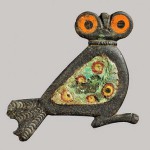Fibula from Bornholm Island (Denmark)
“There are very few of these types of buttons. It is likely that someone travelling to the island carried it there,” – said archaeologist Christina Seehusen from BornholmsMuseum. The clasp was produced in regions along the Roman frontier that ran along the Danube and the Rhine at the time.
According to the specialists, it may originate from Colonia Claudia Ara Agrippinensium (present Cologne) or another nearby town. The clasp was usually worn by men to hold their cloaks closed, so it is possible that a man from the island was a Germanic mercenary in the Roman army and brought the fibula back to Bornholm with him.
Bornholm is located far out in south-west Baltic Sea, but the island was not isolated during the Iron Age. “There have been a number of discoveries in graves and settlements on the island that show there was contact with many parts of the world including frequent contact with parts of the Roman Empire,” said Seehusen.
The Bornholm find was made by Kim Lund-Hansen and Michael Møller. They helped some specialists from BornholmsMuseum explore the south-eastern part of the island. The remains of a large building dating from between the 1st and 4th century AD was also found in the area.
The first Roman settlement – Oppidum Ubiorum, appeared on the site of today’s Cologne in 38 BC. It was founded by Marcus Agrippa. In 15 BC Agrippina the younger was born here, who later became the wife of Emperor Claudius and mother of Emperor Nero.
In 50 AD, Oppidum Ubiorum received the status of a colony. From that time the settlement is called Colonia Claudia Ara Agrippinensium – Colony of Claudius and Altar of the Agrippinians. In the Middle Ages the city was simply called Colony, in the local language it sounded like “Cologne.”
Material is taken from website: http://old.archeo-news.ru. Archaeology. News of the world of archaeology.

